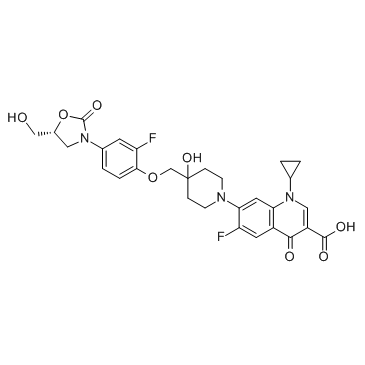1025097-10-2
| Name | 1-cyclopropyl-6-fluoro-7-[4-[[2-fluoro-4-[(5R)-5-(hydroxymethyl)-2-oxo-1,3-oxazolidin-3-yl]phenoxy]methyl]-4-hydroxypiperidin-1-yl]-4-oxoquinoline-3-carboxylic acid |
|---|---|
| Synonyms |
ACT-179811
3-Quinolinecarboxylic acid, 1-cyclopropyl-6-fluoro-7-[4-[[2-fluoro-4-[(5R)-5-(hydroxymethyl)-2-oxo-3-oxazolidinyl]phenoxy]methyl]-4-hydroxy-1-piperidinyl]-1,4-dihydro-4-oxo- UNII-2OEA2UN10Y Cadazolid 1-Cyclopropyl-6-fluoro-7-[4-({2-fluoro-4-[(5R)-5-(hydroxymethyl)-2-oxo-1,3-oxazolidin-3-yl]phenoxy}methyl)-4-hydroxy-1-piperidinyl]-4-oxo-1,4-dihydro-3-quinolinecarboxylic acid |
| Description | Cadazolid (ACT-179811) is a new oxazolidinone antibiotic with potent activity against Clostridium difficile. |
|---|---|
| Related Catalog | |
| In Vitro | Cadazolid is a new antibiotic in development for the treatment of Clostridium difficile-associated diarrhea[1]. Cadazolid is active against all (including linezolid- and moxifloxacin-resistant) Clostridium difficile strains (MIC90 0.125, range 0.03-0.25 mg/L). The cadazolid geometric mean MIC is 152-fold, 16-fold, 9-fold and 7-fold lower than those of moxifloxacin, linezolid, metronidazole and vancomycin, respectively. Both cadazolid dosing regimens rapidly reduce Clostridium difficile viable counts and cytotoxin with no evidence of recurrence. Cadazolid levels persists at 50-100-fold supra-MIC for 14 days post-dosing. Cadazolid inhibition of enumerated gut microflora is limited, with the exception of bifidobacteria; Bacteroides fragilis group and Lactobacillus spp. counts are unaffected. There is no evidence for selection of strains resistant to cadazolid, quinolones or linezolid[2]. |
| In Vivo | Cadazolid is well tolerated up to 3000 mg given twice daily for 10 days. The most common adverse event is headache, with no observed relationship between dose or treatment duration and adverse events. Plasma concentrations of cadazolid are low. No plasma concentrations >3.3 ng/mL are observed after single doses or >6.9 ng/mL after 10 days of multiple doses. Food increased the mean Cmax from 0.73 to 1.87 ng/mL and mean AUC0–t from 3.13 to 15.69 ng·h/mL after a single 300 mg dose. The increase in systemic exposure to cadazolid across doses is less than dose-proportional. The mean cumulative faecal recovery is 81.0%–93.5%. Urinary recovery of unchanged compound is less than 0.015%[1]. |
| Cell Assay | MICs of cadazolid, metronidazole, vancomycin, moxifloxacin and linezolid are determined using agar incorporation for 100 Clostridium difficile isolates, including 30 epidemic strains (ribotypes 027, 106 and 001) with reduced metronidazole susceptibility, 2 linezolid-resistant isolates and 2 moxifloxacin-resistant isolates. The efficacy of two cadazolid dosing regimens (250 versus 750 mg/L twice daily for 7 days) to treat simulated CDI is evaluated. Microflora populations, Clostridium difficile total viable counts and spores, cytotoxin titres, possible emergence of cadazolid, linezolid or quinolone resistance, and antimicrobial concentrations are monitored throughout[2]. |
| References |
| Density | 1.5±0.1 g/cm3 |
|---|---|
| Boiling Point | 832.6±65.0 °C at 760 mmHg |
| Molecular Formula | C29H29F2N3O8 |
| Molecular Weight | 585.553 |
| Flash Point | 457.4±34.3 °C |
| Exact Mass | 585.192261 |
| PSA | 141.77000 |
| LogP | 1.73 |
| Vapour Pressure | 0.0±3.2 mmHg at 25°C |
| Index of Refraction | 1.660 |
| Storage condition | 2-8℃ |
